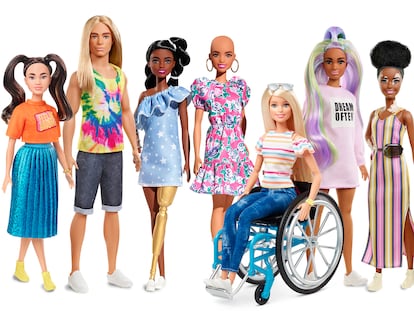The mystery of Ken, the doll in Barbie’s shadow who has spent 50 years in the closet
He has had numerous professions, bodies and skin colors, but questions about his origins and sexuality remain. Now, Ryan Gosling brings him to life on the big screen


A movie about Barbie in 2023? Not about Klaus Barbie, the Nazi war criminal who took refuge in Bolivia, but the Mattel doll. The artifact exists, it is distributed by Warner Bros, it is directed by a skilled filmmaker (Greta Gerwig) and it will be released this summer. The first critical reactions suggest that, despite its kitschy, farcical tone, it has its strong points.
Margot Robbie puts on the skin (it’s a saying) of the eternal apple-cheeked adolescent. As Ken, her friend, companion and maybe-lover, we find Ryan Gosling, who Steve Carrell once described as “America’s boyfriend,” the male counterpart of Ava Gardner. Of course, Gosling isn’t a smooth-skinned teen from Willows Wisconsin, but a good-looking Canadian man who will turn 43. That age difference has given rise to the hashtag #NotMyKen, which a small army of fans uses to accuse Gosling of stealing their childhood and veiling their icon in sordid decrepitude.
Gosling himself, in an interview with GQ and on social media, mentioned the uproar: “I would say, you know, if people don’t want to play with my Ken, there are many other Kens to play with,” he said, “It is funny, this kind of clutching-your-pearls idea of, like, #notmyken. Like you ever thought about Ken before this? You never cared. Barbie never fucked with Ken. That’s the point. If you ever really cared about Ken, you would know that nobody cared about Ken. So your hypocrisy is exposed. This is why his story must be told.” Gosling is right. In the Barbie universe, which joined our own in the late 1950s, Ken has been an absent presence, a man without a backstory, the consort of a queen who left no space for anyone else on the throne.
The man who lost his shadow
In reality, Ken Carson went mostly unperceived in his first decades of existence, between his birth in 1961 and the last years of the 20th century. In all that time, he exercised a sort of neutral masculinity. He sold well, though not as well as Barbie. He was the satellite of a much bigger, more controversial and more fertile planet.
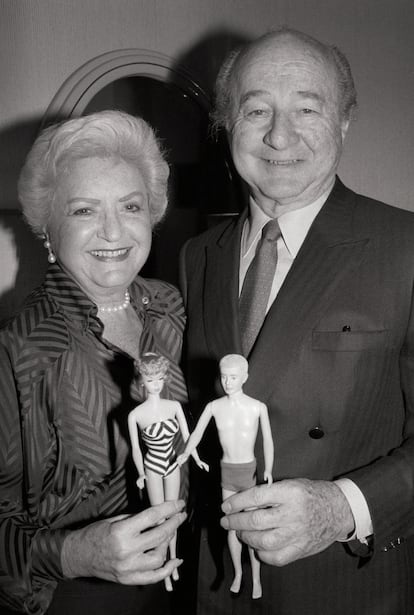
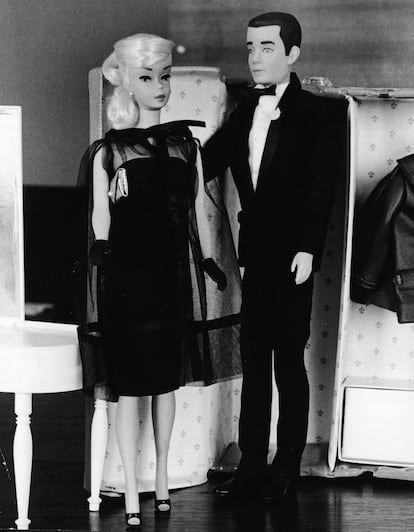
Ruth Handler, creator of Mattel alongside her partner Harold Matson, conceived him as a life partner born out of Barbie’s ribs. She gave him the name of her son Kenneth (the younger brother of Barbara, the girl who inspired Barbie), and she gave him the appearance of a thin, blond, attractive post-adolescent, with a skimpy red bathing suit, sandals and a towel over his shoulders. His arms were rigid until the model Superman Ken went on the market in 1977, but his pectorals gradually expanded until he reached, in the medium-term, the appearance of a steroid-pumped bodybuilder.
Barbie was originally a thinly veiled plagiarism of Lilli, a German doll based on an erotic comic strip, though Handler insists that she didn’t realize until years later that her inspiration was a young prostitute with a BDSM aesthetic: she found the doll at an adult toy fair, but did not see the comic that it was based on. Ken, on the other hand, was based on no one but Barbie. He was her bland male counterpart. Between 1959 and 1961, Handler sold dolls like hotcakes, and little by little, she gave Barbie a trousseau. Upon the completion of the first phase of her world domination plan, she realized, seeing her son Kenneth play with his sister’s dolls, that Barbie was missing one last accessory: a boyfriend. For years, he was one of the only male dolls on the market.
In Ken’s official life story, which was created as the Mattel universe expanded over the years, he was presented as a fresh-faced young man from Wisconsin who enjoyed fishing and surfing and had met Barbie at a casting call. He had courted her with flowers on old-school dinner dates, and she ceded to his charms.
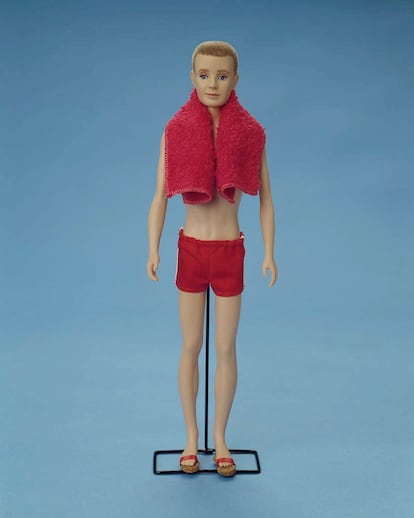

The first Ken fit into that robotic portrait of conventional, radiant youth. His most notable characteristic was a sharp sense of male fashion that led him to embrace, for example, mid-seventies funk style. All Ken had to do was look good and stay out of the way.
Another Ken is possible
Everything started to change at the beginning of our millennium. At that time, Mattel had embarked on efforts to rejuvenate the Barbie brand and adapt it to a mood supposedly Moree plural and diverse. That “progressive” rebranding created controversy, with the appearance of new Kens that departed from the canon. Rivers of ink have been spilled over 2009′s Sugar Daddy Ken. The official reason behind the name was that he was sold with a dog named Sugar.
It was the Asian, African American, bleach-blond, disabled and myopic Kens, which began to proliferate around 2015, that sparked indignation from loyal followers, convinced that Mattel was degrading and “prostituting” its own character. In the option of the GQ reporter Caity Weaver, the most disconcerting thing was that “in a condition of affairs at worst disastrous, at best depraved, Ken, Ken, Ken, and Ken are all dating the same woman. Her name is Barbie.”


At the time, it was an unrequited love. According to the narrative thread that Mattel created for the Barbie universe, the queen of dolls and Ken ceased being a couple in 2004. Russell Arons, the company’s vice-president of marketing, said that they had agreed to “take a break” from their romance, as happens in the best of families and Hollywood’s favorite celebrity couples. The Cosmopolitan journalist Lane Moore wrote that Barbie’s professional success had given Ken low self-esteem. The members of the recently dissolved power couple were glad to remain friends. Ken, in his multiple versions —blonde or brunette, with or without glasses and wheelchair— was committed to keep supporting Barbie.
Mattel went on in the attempt to give its characters a more audacious turn. Limited-edition dolls, including one that represents queer icon and soccer player Abby Wambach, suggested that the company was about to take Barbie out of the closet. But in 2011, coinciding with an alarming drop in Ken sales (which in his condition as a mere “friend” sparked less interest than female companions like Teresa, Nikki and Stacie), the queen and queen of this plastic monarchy decided to give it another go. They started dating again. In 2017, they renewed their vows.
Deep, deep closets
The return to heteronormative monogamy did not stop Mattel, in 2021, from feeding the Barbie-has-a-girlfriend rumors. Everything was based on a series of official images, posted on social media, in which the blonde ambition posed with a doll inspired by the blogger and designer Aimee Song. Both wore a t-shirt with the slogan “Love wins.”
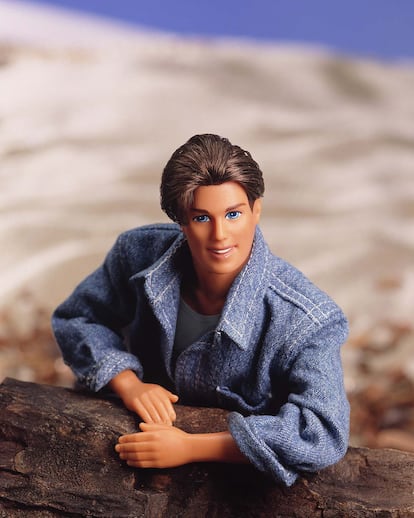
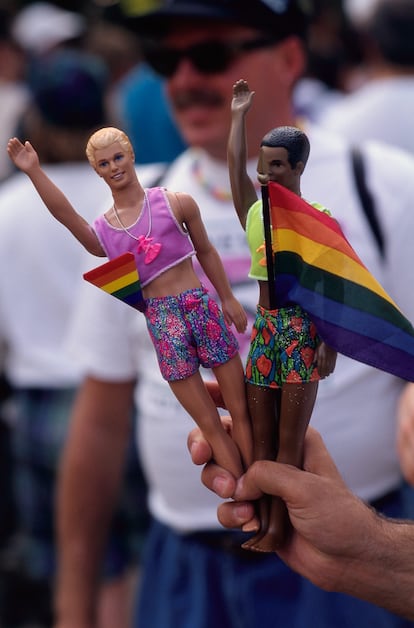
Mattel went on to clarify that, more than a long-anticipated coming-out, it was an act of solidarity and empathy with her sexually diverse followers and with Song herself. Britney McNamara, from Teen Vogue, considers that, in any case, “now and always, Barbie has been too much of a woman for Ken, and sooner or later, she will end up revealing herself as what she really is, a pansexual and polyamorous creature.” McNamara adds that it is “very probably” that the step will lead Ken to finally have his “own moment of sexual self-affirmation.”
Because Ken is gay. Matt Jacobi and Nick Cpario, LGBTI+ activists and avid fans of the doll, have been saying so for years. Jacobi and Caprio ceaselessly insist on Ken’s evident homosexuality. Mattel received them in 2019 for a “work meeting” to discuss how they could introduce the world to a queer Ken, who would not be the character’s canonical version, but one of its official variants.
Mattel doesn’t need to do much to introduce that new twist. They can take a look at the works of Courtney Charles, a New York graphic artist that created his own conceptual and aesthetic reimagining of the character. His series Sexy Ken and Modern Ken have been shown in galleries in New York’s Soho. They expose the Ken that we glimpse beneath Mattel’s patina of conventionality. Charles’s kKen has been a nurse, astronaut, boxer, sheik, gymnast and DJ, always with a daring, contemporary and happily androgynous aesthetic. Compared with Charles’s fertile transgressions, any licenses that Gosling and Gerwig take in the film will look to us like child’s play.
Sign up for our weekly newsletter to get more English-language news coverage from EL PAÍS USA Edition
Tu suscripción se está usando en otro dispositivo
¿Quieres añadir otro usuario a tu suscripción?
Si continúas leyendo en este dispositivo, no se podrá leer en el otro.
FlechaTu suscripción se está usando en otro dispositivo y solo puedes acceder a EL PAÍS desde un dispositivo a la vez.
Si quieres compartir tu cuenta, cambia tu suscripción a la modalidad Premium, así podrás añadir otro usuario. Cada uno accederá con su propia cuenta de email, lo que os permitirá personalizar vuestra experiencia en EL PAÍS.
¿Tienes una suscripción de empresa? Accede aquí para contratar más cuentas.
En el caso de no saber quién está usando tu cuenta, te recomendamos cambiar tu contraseña aquí.
Si decides continuar compartiendo tu cuenta, este mensaje se mostrará en tu dispositivo y en el de la otra persona que está usando tu cuenta de forma indefinida, afectando a tu experiencia de lectura. Puedes consultar aquí los términos y condiciones de la suscripción digital.
More information

Why does Barbie walk on her tip toes?
Archived In
Últimas noticias
Welcome to the post-religion era: The idea of Christianity as the absolute truth has become obsolete
‘I thought you would like it’: The risky sexual practice popularized by TV shows and TikTok
The digitalization of tourism: ‘They promise experiences and gave us the worst possible one’
Mexican peso defies uncertainty with forecasts of a new period of stability in 2026
Most viewed
- Sinaloa Cartel war is taking its toll on Los Chapitos
- Reinhard Genzel, Nobel laureate in physics: ‘One-minute videos will never give you the truth’
- Oona Chaplin: ‘I told James Cameron that I was living in a treehouse and starting a permaculture project with a friend’
- Why the price of coffee has skyrocketed: from Brazilian plantations to specialty coffee houses
- Silver prices are going crazy: This is what’s fueling the rally
